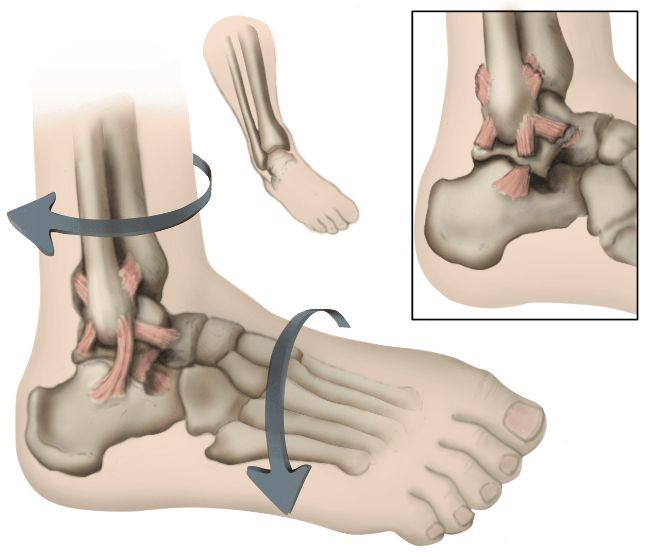
Symptoms & Causes of Ankle Sprains
Symptoms
The signs and symptoms of a sprained ankle can vary depending on the seriousness of the injury. They might include:
- Pain, particularly when putting weight on the injured foot
- Tenderness upon touching the ankle
- Swelling
- Bruising
- Limited range of motion
- Instability in the ankle
- A popping sensation or sound at the time of injury
Causes
A sprain happens when your ankle is pushed beyond its usual range of motion, leading to stretching, partial tearing, or complete tearing of one or more ligaments in the ankle.
Possible causes of a sprained ankle may include:
- Falling and twisting your ankle
- Awkwardly landing on your foot after jumping or pivoting
- Walking or exercising on an uneven surface
- Someone else stepping or landing on your foot during a sports activity.
Risks & Complications
Risks
Factors that elevate the likelihood of an ankle sprain include:
- Sports involvement: Ankle sprains are frequent in sports that involve jumping, abrupt changes in direction, or foot movements like rolling or twisting, such as basketball, tennis, football, soccer, and trail running.
- Uneven surfaces: Walking or running on uneven terrain or subpar field conditions can heighten the risk of an ankle sprain.
- Previous ankle injury: Once you’ve experienced a sprained ankle or any other form of ankle injury, the chances of spraining it again increase.
- Suboptimal physical condition: Weakness or lack of flexibility in the ankles can amplify the risk of a sprain during sports activities.
- Inappropriate footwear: Ill-fitting shoes or those unsuitable for a specific activity, including high-heeled shoes in general, can leave ankles more susceptible to injury.
Complications
Not properly following ankle sprain treatment, returning to activities prematurely after an injury, or experiencing repeated ankle sprains could result in the following issues:
- Persistent ankle pain over time.
- Long-term instability in the ankle joint.
- Development of arthritis within the ankle joint.
Prevention
How can I avoid spraining my ankle? You can decrease the likelihood of future sprains by:
- Use an elastic bandage to wrap the injured ankle.
- Use a brace if needed.
- Engaging in strengthening exercises.
- Steer clear of high heels.
- Always warm up before exercising.
- Opt for sturdy, well-made footwear.
- Be mindful of the surfaces you walk on.
- Ease off or stop activities if you start feeling tired.
Diagnosis & Treatment
Diagnosis
Your orthopedic surgeon will assess your sprained ankle through a physical examination of your foot and ankle to assess your range of motion and identify the affected ligaments. This examination is usually followed by an imaging test, such as an X-ray, MRI, CT- Scan, Ultrasound.
Ankle Sprain Treatment
Ankle Sprain Treatment- Home Treatment
You may manage mild sprains at home with the following recommended sprained ankle treatment options:
- Wrap your ankle with elastic bandages like an ACE bandage, ensuring not to wrap too tightly.
- Wear a supportive brace for ankle support.
- Use crutches if necessary.
- Elevate your foot with pillows as needed to reduce swelling.
- Take ibuprofen (such as Advil) or acetaminophen (such as Tylenol) to alleviate pain.
- Rest your ankle and avoid putting weight on it.
Applying ice to the injured area promptly can also help reduce swelling. On the first day, apply ice every 20 to 30 minutes, three to four times a day. After that, apply ice every three to four hours for the next two days.
Ankle Sprain Treatment- Surgical Treatment
Surgery for ankle sprains is uncommon. It may be considered in cases of severe ligament damage resulting in instability or when nonsurgical treatments fail to improve the condition. Surgical sprained ankle treatment options include:
- Arthroscopy: This procedure involves a surgeon examining the joint to identify any loose bone or cartilage fragments.
- Reconstruction: In reconstruction surgery, surgeon Dr Preetesh Choudhary repairs the torn ligament using stitches. They may also utilize other ligaments or tendons from around the foot or ankle to repair the damaged ligaments.
